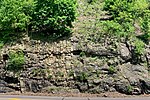Hamilton Group

The Hamilton Group is a Devonian-age geological group which is located in the Appalachian region of the United States. It is present in New York, Pennsylvania, Maryland, Ohio, West Virginia, northwestern Virginia and Ontario, Canada, and is mainly composed of marine shale with some sandstone. There are two main formations encompassed by the group: the Mahantango Formation and the Marcellus Shale. In southwestern Virginia, where the two sub-units are not easily distinguishable, the Hamilton Group is broadly equivalent to the Millboro Shale or Millboro Formation.The group is named for the village of Hamilton, New York. These rocks are the oldest strata of the Devonian gas shale sequence.
Excerpt from the Wikipedia article Hamilton Group (License: CC BY-SA 3.0, Authors, Images).Hamilton Group
Mid-State Trail,
Geographical coordinates (GPS) Address Nearby Places Show on map
Geographical coordinates (GPS)
| Latitude | Longitude |
|---|---|
| N 40.734722222222 ° | E -77.778333333333 ° |
Address
Mid-State Trail
Mid-State Trail
16827
Pennsylvania, United States
Open on Google Maps








